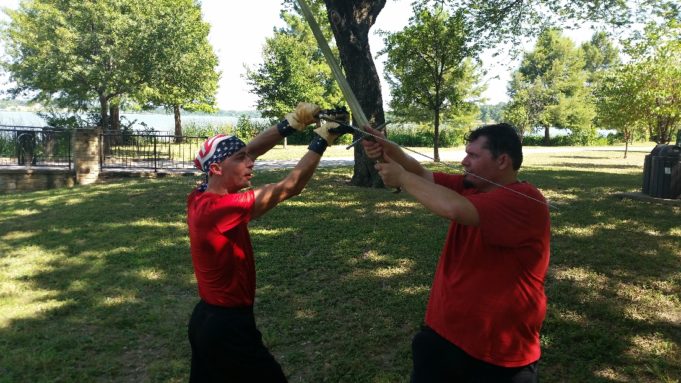The bright sound of clanging steel broke through an otherwise quiet, balmy summer day near White Rock Lake in Dallas. As joggers and other passersby paused to stare at the curious sight of grown men engaged in combat with medieval weaponry, Joshua Sanderlin directed the sparing swordsmen.
Sanderlin has put in more than five years of study through the historically informed combat group ARMA (Association for Renaissance Martial Arts). His weapon of choice: the long sword. At three feet in length and with a long slender blade, the long sword was the weapon of choice for elite soldiers and nobility during the renaissance.
Learning how to master the saber has required countless hours studying centuries-old manuscripts from long deceased masters and more than a few bumps and bruises.
“It can be very dangerous, but one of the things we stress here is safety,” he said. “If you’re here to hurt people someone else is going to one-up you or no one is going to want to spar with you because you’re a jerk. Most of the people that are doing this just they really want to learn.”
Before sparring with blunted variants of the long sword, ARMA members don protective head gear (similar to what fencers use), gloves, and protective cups for their, um, man parts. It doesn’t seem like a lot of protection, but that’s the idea.
“We’re practicing unarmored combat,” he said. “We want to move accordingly and feel when we get hit and we want our opponent to feel when they get hit. With a bunch of protective gear you can stand around and smack each other all day. We’ve had a few broken fingers, but we’re continually learning and striving to eliminate that.”
Burleson resident Dennis Johnson regularly makes the hour-long commute on Sunday to practice with his comrades in arms. At the moment, only Dallas and Denton have ARMA chapters, but Johnson and Sanderlin are hoping a Fort Worth chapter starts one day. There are several misconceptions people have about what we do, Johnson said.
“When you say martial arts everyone thinks of the Asian fighting arts,” he said. “But the term comes from Latin. Martial arts means the art of Mars, god of war. Every culture had its own unique fighting system and tradition.”
Sometimes Johnson describes the art form as historical sword fighting. But that doesn’t work much better.
“That makes my friends think I’m running through the park with elf ears and shooting magical arrows,” he said with a laugh.
The fact is, delving into the largely lost art of sword fighting isn’t as glamorous as the staged fighting scenes in movies like Lord of the Rings or theatrical events like Scarborough Renaissance Festival, but that’s what Johnson loves about the craft. It was obvious, he said, that when he first visited the Dallas group that “they were in earnest about learning real techniques that would be effective in a real fight.”
“A lot of our training techniques come from manuscripts from the Renaissance era,” Sanderlin said. “The oldest source dates back to around 1297.”
The training would have been used in combat, he said, but surviving duels or preventing a robbery were also practical reasons. Schools that focused on swordsmanship would have been affordable to middle class merchants and the like throughout the Renaissance and into the Baroque eras.
While the long sword is a favorite weapon of choice for Dallas members of ARMA, the training encompasses several other period weapons like the messer (a long machete-like knife), spear, shield and buckler (small sword), and rapier (popularized in The Three Musketeers).
The day ended with minor cuts, bruises, and a few welts, but everyone seemed in high spirits. Two potential members, including young women from Arlington and a young man from Euless, said they enjoyed their first ARMA experience. Noticeably fatigued and dripping with sweat, Johnson said the experience has had many surprises.
“It is very physical,” he said. “You’re moving in ways your body isn’t typically used to. It’s obvious why back then they trained every day until this became second nature. It truly is an art and it takes a long time to master this.”











